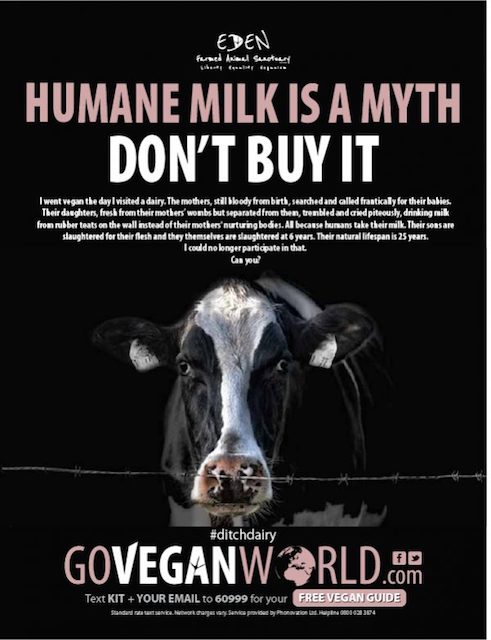
As of yesterday, Wednesday, July 26th, vegans can officially call milk production “inhumane” after the Advertising Standards Authority (ASA) ruled in favor of an anti-dairy campaign.
The advert was run by Go Vegan World and states that, “Humane milk is a myth.” ASA, the advertisement governing body in the U.K., approved the ad, despite seven complaints, mostly from people who had experience working in the dairy industry. Those opposed to it said that the ad was inaccurate, that it was misleading, and questioned whether the claims could be substantiated.
The advert, which was published in the Sunday Telegraph in February, featured a photo of a cow behind a piece of barbed wire and the headline, “Humane milk is a myth. Don’t buy it.”
Other text in the ad stated, “I went vegan the day I visited a dairy. The mothers, still bloody from birth, searched and called frantically for their babies. Their daughters, fresh from their mothers’ wombs but separated from them, trembled and cried piteously, drinking milk from rubber teats on the wall instead of their mothers’ nurturing bodies. All because humans take their milk.”
The advertising regulator explained that the complaints were from people who believed the ad did not accurately describe the way dairy cattle were generally treated in the U.K.
ASA explained their reasons for clearing the ad, saying they understood the complainants were concerned that the ad implied a significant number of dairy farms did not comply with animal welfare standards in place in the U.K. and that, therefore, milk production was “inhumane”—but, in that sense, they did not believe it misled people.
ASA determined that people would realize the comments in the advert were purely the opinions of the vegan group. The regulator concluded, “Although the language used to express the claims was emotional and hard-hitting, we understood it was the case that calves were generally separated from their mothers very soon after birth, and we therefore concluded that the ad was unlikely to materially mislead readers.”
ASA considered, “That readers, who were unlikely to have specialist knowledge of the dairy industry, would understand the claim, ‘their daughters, fresh from their mothers’ wombs, but separated from them,’ to mean that calves were generally separated from their mothers very soon after being born rather than a comment on compliance with any specific welfare standards.”
Those who complained about the advert believed it described the separation of mothers and their calves in an inaccurate and misleading way.
However, Go Vegan World explained that the advert did not state or imply that calves were separated from their mothers prior to the 12 to 24 hours recommended by Defra, the Department for Environment, Food, and Rural Affairs.
Sandra Higgins, Go Vegan World’s Director, explained, “The exact timing of the separation is irrelevant because, to most people, separation at 25 hours is as unjust as separation at 24 hours. Late separation does not ease the distress; in fact, late separation causes more distress to cow and calf, as Go Vegan World illustrated in their submission of relevant scientific studies.”
Michael Oakes, the national dairy board chairman of the National Farmer’s Union (NFU), said they were “angry and disappointed” with the ruling and felt let down by the ASA. The NFU intends to appeal while Go Vegan World, based in the Republic of Ireland, described the ruling as a “landmark.”
Higgins explained, “The aim of the ad is to let people know that no matter where the milk and dairy products they purchase have come from, whether an industrial-scale dairy farm or a smallholding, for each cow, legal, standard practice necessitates her pregnancy, the removal of her calf, and her slaughter, so that we can drink the milk that she produced to feed her infant.” She continued, “The ad highlights that the problem faced by animals in the dairy industry is not how they are treated, but that they are used at all.”
Despite what many people prefer to believe, it is a myth that all cows live in pastures on rural farms, free to roam, and free from pain and suffering. It is also a myth that cow’s milk is intended for humans.
No other species drinks milk past infancy, and no other species drinks milk from other species.
Nature’s intentions for cow’s milk were not for humans, but so that baby calves could drink their mother’s milk. However, this is now a rare occurrence in the dairy industry.
Cows typically have a lifespan of approximately 25 years, but tragically, their lives are cut short as they are sold for meat once they have survived being a slave for four to five years in the milk industry.
Dairy cows, from 15 months old, are—forcibly and brutally—artificially inseminated once a year using a constraining device, known as a “rape rack.” The semen is inserted through the cow’s rectum and vagina into her uterus, without painkillers.
A dairy cow goes through the distress and anxiety of losing her babies approximately between four to seven times, which takes an enormous emotional and mental toll on the mother.
They spend most of their short lives pregnant so that they are lactating and able to feed their babies. They carry their babies for nine months—the same length of time as humans—however, many will never receive the opportunity to nurse their young.
Within hours of a calf being born in the dairy industry, 97 percent are stolen from their mothers and the other 3 percent are ripped away within days. Wildlife experts say a strong bond between a cow and a calf is formed instantly following birth.
On many so-called “humane” dairy farms, calves are taken away within an hour, as it is believed that may be the least distressing solution.
Cows have the same primal instincts to protect, nourish, and nurture their young as humans do. Just as any new parents bond with a baby, mother cows are the same. Just as a human baby cries if his mother leaves the room, a calf cries out for its mother too.
Those who have witnessed the traumatic scenes and heard the cries coming from dairy farms when mothers and babies are torn apart describe the noise as being a deafening mixture of bellowing and whining along with a desperate and frantic physical attempt to remain together. These cries have been heard from mothers for up to six weeks afterward, and often longer.
Calves become frantic when they are removed from their mothers and will continue searching for them, trying to return to the last place they have seen them.
Mother cows—who are known to exhibit various different emotions from forming lifelong bonds and playing games with their babies—have been previously known to break out of fields to search for and be reunited with their calves that have been taken to auction.
Instead of experiencing motherhood, cows are confined to a life of suffering as merely a milk-producing machine.
Sometimes the mother and baby are tortuously placed at different parts of the same farm so that they can still see, sense, and smell one another, but are too far apart to touch, feed, and bond.
At only a day or two old, many male calves are taken to feedlots to await their slaughter, while others are kept in dark, tiny crates almost completely immobilized so that their flesh remains tender. To ensure the flesh stays white, they are fed a low-iron liquid diet which has barely any nutrition. This often makes them ill and many suffer from anemia, diarrhea, and pneumonia. Due to the illnesses calves endure, they are then given huge doses of antibiotics and other drugs to keep them alive—temporarily.
Alone, terrified, and sick, the calves are then killed when they are just a few months old so that their flesh can be sold as veal.
Male calves are surplus to the dairy industry and across the world 21 million of them are slaughtered for veal or cheap beef every year—or, perhaps even more disturbingly, first sent to partake in rodeos before a chilling, early death.
Without the dairy industry, the veal industry would not exist. This horrendous suffering is simply a by-product of humans’ desire to drink milk.
Most female calves will begin the same life cycle of slavery and suffering that their mothers endure.
As soon as the baby calves are taken from their mothers, the cows are then hooked up to machinery to produce milk for human consumption. Cows are often given hormonal drugs so that they are capable of producing far more milk than they naturally would.
More than 90 percent of U.S. cows are confined to a life indoors, with 60 percent being tethered at the neck and unable to carry out basic behaviors essential for their well-being.
Many cows become lame due to poor restriction, damp and acidic housing from urine and feces, and an enlarged udder. A cow generally only carries a maximum of two liters of milk in her udder at any time, but due to drugs many are carrying 20 liters or more. This causes her udder to become so heavy it can make her lame. She may also develop an agonizing infection called mastitis.
Every investigation that Mercy For Animals carried out at a dairy factory farm exposed widespread, horrifically sadistic, and needless acts of cruelty toward animals.
Following these investigations—that are usually randomly conducted—various workers, managers, or owners have received criminal charges or convictions after being caught viciously beating, kicking, or dragging animals.
Apart from the cruelty aspect, various scientific studies have shown that cow’s milk is not healthy for the human body. An assortment of detrimental health effects have been linked directly to milk consumption.
Often people are wary of dairy-free alternatives, as they have become accustomed to the tastes of their regular brands. However, alternatives are deliciously flavored and purchasing cruelty-free far outweighs small taste differences. There are many options available such as soy, rice, coconut, or almond milk. It is simple to replace dairy products with cruelty free ones—supermarkets are usually stocked with a variety of alternatives.
People often think the alternative option is organic however organic is not cruelty-free either. Whilst the cruelty is minimized, the bodies of the cows are often exhausted and emotionally traumatized due to the separation anxiety caused when their babies are torn away from them. They still face the same chilling doors of the slaughterhouse.
Please be conscious when purchasing meat and dairy products and, when possible, carry out research beforehand to ensure that this systematic abuse and these cruel practices become a thing of the past.
The best way to stop the misery and suffering described above is to stop buying milk and other dairy products. Often people become vegetarian believing that the meat industry is barbaric, but in many ways the dairy industry is far more horrific.
Slowly, society is waking up to what goes on behind closed doors in the dairy industry. Ten years ago there were over 21,000 dairy farms in the U.K. and this number has now been reduced to just 5,000.
Not only is the dairy industry cruel, it is also detrimental to the environment as every day cows produce 150 billion gallons of methane. It also plays a huge part in sustaining world hunger.
For more information, please watch the videos below that explain the true cost of dairy:
*Warning: These videos contain disturbing scenes.
~
~
~
~
~
Author: Alex Myles
Image: GoVeganWorld.com
Editor: Leah Sugerman
Copy Editor: Khara-Jade Warren
Social Editor: Khara-Jade Warren
 Share on bsky
Share on bsky





Read 0 comments and reply